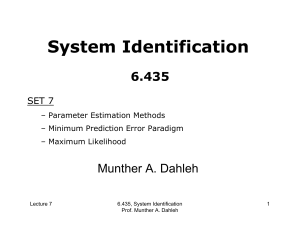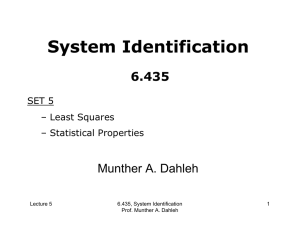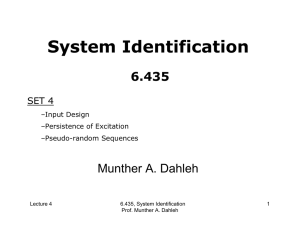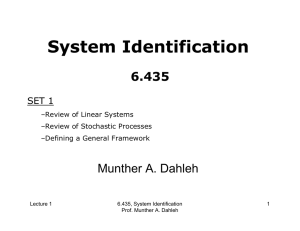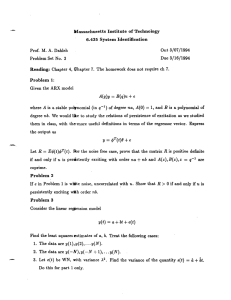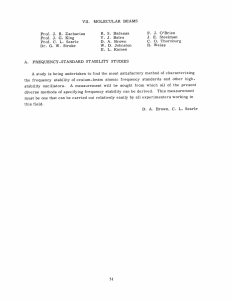System Identification 6.435 Munther A. Dahleh SET 3
advertisement
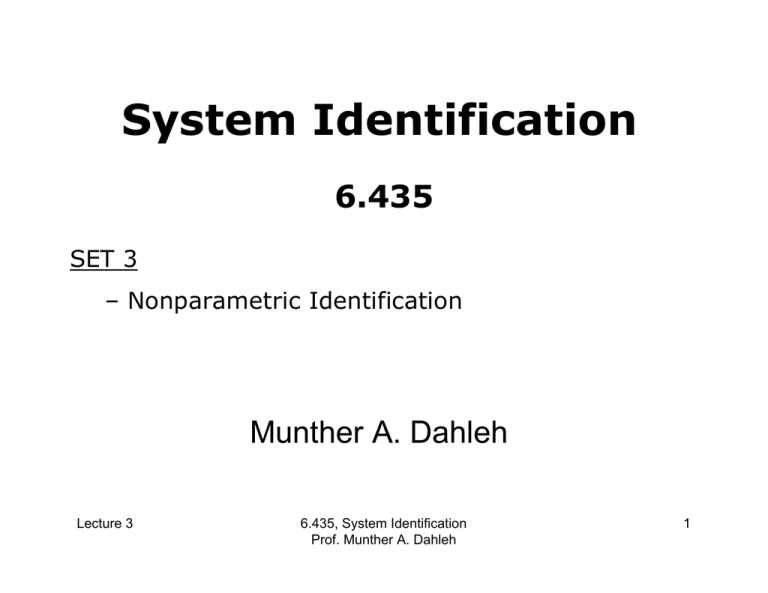
System Identification
6.435
SET 3
– Nonparametric Identification
Munther A. Dahleh
Lecture 3
6.435, System Identification
Prof. Munther A. Dahleh
1
Nonparametric Methods
for System ID
• Time domain methods
– Impulse response
– Step response
– Correlation analysis / time
• Frequency domain methods
– Sine-wave testing
– Correlation analysis / Frequency
– Fourier-analysis
– Spectral analysis
Lecture 3
6.435, System Identification
Prof. Munther A. Dahleh
2
Problem Formulation
Black
Box
• Actual system
is Linear time-invariant stable.
• Process:
• Time domain methods ⇒ estimates of
• Frequency-domain methods ⇒ estimates of
Lecture 3
6.435, System Identification
Prof. Munther A. Dahleh
3
• Tests:
a)
at each freq.
b)
c)
d)
Lecture 3
6.435, System Identification
Prof. Munther A. Dahleh
4
Time-Domain Methods
• Impulse response
estimate:
Analysis:
small if
Practicality: not very useful.
Lecture 3
6.435, System Identification
Prof. Munther A. Dahleh
5
• Step response
estimate:
Analysis:
Practicality: Not good for determining
determining delays, modes….
Lecture 3
6.435, System Identification
Prof. Munther A. Dahleh
. Good for
6
Methods (Continued)
• Correlation Analysis
• Assume u is quasi-stationary
are uncorrelated.
•
Lecture 3
6.435, System Identification
Prof. Munther A. Dahleh
7
• Case I:
If
To estimate:
Lecture 3
6.435, System Identification
Prof. Munther A. Dahleh
8
• Case II:
Input is not white.
Using the approximation
In matrix form:
notice
Lecture 3
6.435, System Identification
Prof. Munther A. Dahleh
9
⇒
Estimate
• Question: Under what conditions the above system has a unique
solution? Persistency of excitation!
• Note that you get the same estimate regardless of the spectrum
of the noise.
Lecture 3
6.435, System Identification
Prof. Munther A. Dahleh
10
Analysis of Correlation Method
• Estimate
•
• Need to determine the covariance of
Lecture 3
6.435, System Identification
Prof. Munther A. Dahleh
for a fixed large N.
11
•
•
• Covariance, proportional to
Lecture 3
6.435, System Identification
Prof. Munther A. Dahleh
12
Frequency-Response Analysis
• Input
• Extract
• How do you measure
A good approach is correlation.
Lecture 3
in the presence of noise?
6.435, System Identification
Prof. Munther A. Dahleh
13
• Define
•
•
Lecture 3
6.435, System Identification
Prof. Munther A. Dahleh
14
• Estimate:
• Comment:
Lecture 3
6.435, System Identification
Prof. Munther A. Dahleh
15
Empirical Transfer Function
Estimate (ETFE)
• For an arbitrary input
• Recall:
• If
Correlation analysis
, then the previous analysis shows that
• Similarly for u = White input.
Lecture 3
6.435, System Identification
Prof. Munther A. Dahleh
16
• General Procedure
1. Calculate
2. Obtain the inverse DFT:
3. Define
• The algorithm is quite efficient; requires only the computation of
the Inverse DFT. Note also that the algorithm is Linear.
Lecture 3
6.435, System Identification
Prof. Munther A. Dahleh
17
Properties of EFTE
Theorem:
Given:
With:
•
• s(t) is stationary, zero mean with spectrum
•
Lecture 3
6.435, System Identification
Prof. Munther A. Dahleh
18
Then:
1.
2.
Lecture 3
6.435, System Identification
Prof. Munther A. Dahleh
19
Proofs
• Bias
• Covariance
1st: Compute
Lecture 3
6.435, System Identification
Prof. Munther A. Dahleh
20
Lecture 3
6.435, System Identification
Prof. Munther A. Dahleh
21
•
•
•
Lecture 3
6.435, System Identification
Prof. Munther A. Dahleh
22
• Put together
Now:
Lecture 3
6.435, System Identification
Prof. Munther A. Dahleh
23
Comments on EFTE
• Suppose U = periodic
increases as a function of N for some
and zero for others
—
EFTE is defined for a fixed number of frequencies,
i.e. independent of N.
—
Lecture 3
At these frequencies, ETFE is unbiased and
Covariance decays as . (Recall
).
6.435, System Identification
Prof. Munther A. Dahleh
24
• Suppose V is a stochastic process, uncorrelated with v
in dist.
(a bounded function)
– ETFE is asymptotically unbiased, with increasingly more welldefined frequencies (as N → ∞).
– The variance does not decrease as N → ∞.
– Estimates are asymptotically uncorrelated.
Lecture 3
6.435, System Identification
Prof. Munther A. Dahleh
25
Spectral Estimation
• Traditionally
estimate
N-Long time series
• In here, different context.
• Theme:
– Show the mechanics
– Importance of windowing, tradeoffs
– Relate to spectral estimation
Lecture 3
{smaller variance}
6.435, System Identification
Prof. Munther A. Dahleh
26
Spectral Estimation: Non Std
(Ljung)
• Idea: the actual function
is smooth. The values of
should be related for small intervals ω.
• According to previous analysis,
and has variance
• Suppose
Lecture 3
is uncorrelated with
satisfies
6.435, System Identification
Prof. Munther A. Dahleh
27
• Define the estimate (new) at
• Where
is minimized.
as follows:
are chosen so that
• Solution:
Lecture 3
6.435, System Identification
Prof. Munther A. Dahleh
28
• As N → ∞, the sums
Lecture 3
integrals
6.435, System Identification
Prof. Munther A. Dahleh
29
• Equivalently: Let
• If
Lecture 3
be a window function. Then,
is unknown, but slowly varying in frequency
6.435, System Identification
Prof. Munther A. Dahleh
30
Relations to Traditional
Spectral Analysis
• Recall:
in
distribution
estimate
of
Lecture 3
6.435, System Identification
Prof. Munther A. Dahleh
31
• Define:
•
Similarly:
• Conclusion
Lecture 3
6.435, System Identification
Prof. Munther A. Dahleh
32
Efficient Computation
•
Of course
for
large enough but not as large
as N. Example is:
(Bartlett)
• Similarly for
Lecture 3
6.435, System Identification
Prof. Munther A. Dahleh
33
Analysis of Spectral Estimation
•
and
•
Lecture 3
6.435, System Identification
Prof. Munther A. Dahleh
34
• Write
• Recall:
Lecture 3
6.435, System Identification
Prof. Munther A. Dahleh
35
Numerator
•
Denominator
Numerator:
Denominator:
•
⇒ for each finite
Lecture 3
, the estimate is biased.
6.435, System Identification
Prof. Munther A. Dahleh
36
•
•
• For a fixed
• Improved variance on the expense of the biase.
Lecture 3
6.435, System Identification
Prof. Munther A. Dahleh
37
Estimating the Disturbance Spectrum
•
• If
was measurable, then
Bias:
Variance
• Problem:
Lecture 3
is not readily measurable.
6.435, System Identification
Prof. Munther A. Dahleh
38
• The residual spectrum.
is the estimate
•
• Define
•
Lecture 3
6.435, System Identification
Prof. Munther A. Dahleh
39
